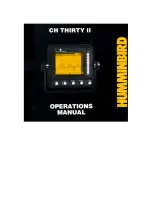
Note: While familiarizing yourself with the CH-THIRTY II, it is suggested you run the paper speed
between 9 and 10 o’clock for the first couple rolls of paper.
2. Depth Range: Your CH-THIRTY II offers a choice of four depth ranges. The upper most
position represents the 0-30 foot range. This is the shallow range on the unit and is excellent
for water less than 30 feet deep. Bass fishermen will find this an ideal range for most of their
fishing. An ideal setting for crappie, walleye. pike, muskie, and bluegill, as most of this fishing
will be done in shallow water.
The Second position is the 0-60 foot range. This could be the most widely used range on the
unit. A good all-around setting for the freshwater angler, the 60 foot range will give excellent
detail in shallow as well as moderately deep water. Great Lakes anglers will find this 60 foot
range ideal for early spring and late fall when the runs are shallow. The 0-120 foot range is
ideal for open water in both fresh and salt water situations. When water exceeds 60 feet deep
it is suggested the 120 foot scale be utilized. A good setting for trolling deep inland lakes and
excellent for Great Lakes operation. This will also be an ideal range for close offshore fishing
where the water is up to or slightly in excess of 100 feet deep.
The deep range on the unit is the 0-240 foot setting. This range will be best suited for inland
port navigation, deep Great Lakes fishing and for salt water angling.
You will not detect any change in the speed of the stylus belt when changing from the 0-
30and 0-60 foot ranges. However, as you may switch to the 0-120 foot range, the belt speed
will slow down. It will slow down sgsin when you switch from the 0-120 to the o-240 foot
range. This change in belt speed will only affect the depth. It will have no effect on the speed
of the paper.
Your Humminbird chart paper is lined, and these lines can help pinpoint your target by
knowing the depth represented based upon the depth range of the unit. For example, on the
30 foot scale, the distance between the lines is 2 ½ feet. On the 60 foot scale the lines
represent five foot increments. On the 120 foot scale, each line represents a 10 foot
increment and on the 240 scale, the distance between represents 21 feet.
4. Noise Reject: This control will help eliminate interference due to external noise sources. If no
interference is evident, this knob should be rotated to the full counterclockwise position. If noise
interference is present, this control should be turned clockwise until the interference is just
eliminated and no more.
Remember that when you are using the noise reject, you are losing target resolution.
Resolution is the ability to detect distance between or separation of objects. Be sure that all
other depth sounders on the boat are turned off while operating the chart recorder.
5. White Line: The control on the far right is your white line feature. Your Chart is equipped with
this control for better target identification and bottom definition.
The white line feature is off when the control knob is turned completely counter-clockwise. By
turning the knob clockwise the white line feature is activated. The display on the paper will
become illustrated by a light gray signal beneath the actual bottom signal.
The wider the bottom signal, the harder the bottom composition. The softer the bottom, such
as mud or weeds returning a weaker echo, the bottom signal will be considerably narrower.
Your white line will help identify fish, especially large fish which are laying very near the
bottom. The fish will arc with the top being black and the lower part gray, while the bottom
itself will display a thin black line under the fish.
When attempting to locate a relatively hard surface in a soft bottom condition, the white line
Summary of Contents for CH Thirty II
Page 1: ......















